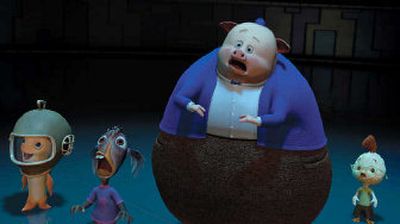Seemingly innocent

A shotgun-wielding hunter mercilessly pursues his target. Angry space aliens vaporize a defenseless town. A bloodthirsty shark preys on the weak and tiny.
These movie scenes aren’t from the latest action thrillers – they’re from G-rated animated films like Disney’s new “Chicken Little.”
As pop culture mimics today’s permissive social values, violence and veiled sexual references have crept into the seemingly innocent cartoon landscape, giving parents new reason to do research beyond the ratings.
It’s not that the Motion Picture Association of America’s ratings board has become more permissive, says MPAA president Dan Glickman: “It’s bound to be a reflection of society.”
It’s also a reflection of movie studios following the formula of hits like the “Toy Story” and “Shrek” films, whose sophisticated scripts include plenty of subtle jokes aimed at adults.
So the octopus-armed alien robots in “Chicken Little,” who shred a cornfield and use their laser-gaze to zap away the town’s animal citizens, are just typical cartoon characters. The film’s allusion to “Girls Gone Wild” is just another cultural reference. The melons held chest-high by the heroine in “Wallace & Gromit” are just large pieces of fruit.
“Everybody is trying to reach out to as wide an audience as possible,” says Disney spokesman Dennis Rice. “It may have some adult humor that goes over the heads of other audiences, but it’s never so colorful that it would affect the MPAA and how they rate the movie.”
Historically, cartoons have always contained some strong elements. Bambi’s mother is shot and killed in the 1942 Disney classic, and Daffy Duck took many a shotgun blast from Elmer Fudd.
Glickman cites old Road Runner cartoons, where all sorts of unthinkable things happened to the Coyote.
“We like to think that things are more violent today, and it may be,” he says. “But 30 or 40 years ago, there were a lot of things falling on heads and dropping off cliffs.”
But as animation techniques become more sophisticated, the cartoon world looks more like reality, says Elayne Rapping, professor of film history and theory at the University of Buffalo.
“We become increasingly desensitized, so movies have to be more and more viscerally exciting,” she says.
A series of Harvard studies confirms that violence has increased during the history of animated G-rated films. In one study, more than half of all G-rated animated features showed characters using alcohol or tobacco. These movies are also likely to contain more violent content than their live-action counterparts.
A G rating means the movie is “good for all audiences,” containing nothing that would be offensive to parents whose younger children view the film. But culture isn’t static, and not all people have the same values, so the definition of “offensive” can vary wildly.
“It’s not the MPAA’s fault,” says James Steyer, chief executive of Common Sense Media, a nonprofit parent resource group. He founded the organization in 2003 to provide parents with more insight into children’s entertainment.
“Standards have been inconsistent,” he says. “Parents need to be better-informed consumers on behalf of their kids.”
Common Sense Media and similar organizations, such as Parent Previews and Kids-in-Mind, offer their own ratings systems and provide additional details for parents about the content of popular movies.
They note the potential scariness of sharp-toothed sharks in “Finding Nemo,” for example, and warn parents of the bawdy humor and armed hunter in “Wallace & Gromit.” Both films earned G ratings.
Though most kids understand cartoons aren’t real, they can still be affected by what they see. Some children imitate name-calling or bullying they witnessed on screen, or fear that something they saw in a movie could happen in real life, says pediatrician Ken Haller, a professor at Saint Louis University School of Medicine.
Providing context is key to helping children make sense of an increasingly media-saturated world, he says.
“Parents think of animated feature-length films, even going back to ‘Snow White,’ as being a safe harbor they can put their kids in front of and not worry about,” Haller says. “All the animated films involve violence or threats of violence. Snow White gets poisoned.
“The problem is when kids don’t have anyone to help them process these things.”